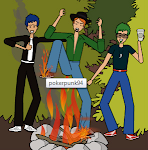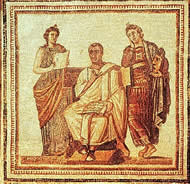
Gladiator is from the Latin "gladius" which means "sword". Gladiators were professional fighters who battled for the enjoyment of the audience in the ampitheathers they performed in. The Coliseum was the most famous amphitheater that gladiators fought in (see The Coliseum and it's Architecture post). Gladiators were mostly males and were mostly slaves, condemned criminals, prisoners of war, and sometimes Christians. The largest amount of gladiators in one event was 5000 pairs of fighters. They were forced to become swordsmen and trained in schools called ludi. Special measures were taken to prevent them from commiting suicide. A successful gladiator received great acclaim. He was pampered and sometimes portrayed on art. Some gladiators who survived were let free. Occasionally, freedmen and Roman citizens fought, and once the mad Emperor Commodus entered the arena. The classes of fighters were light armored or heavy armored. The retiarius (net man) tried to entangle the fully armed secutor (pursuer) with a net and then kill him with a trident. Other classes fought with different weapons, and sometimes used horses or chariots. According to tradition, when a gladiator overpowered his opponent, he looked to the crowd to decide wether he should live or die. The crowd waved handkercheifs if they wanted the felled gladiator to be spared and turned down their thumbs if they wished for his death. Gladiator matched continued until A.D. 500.









